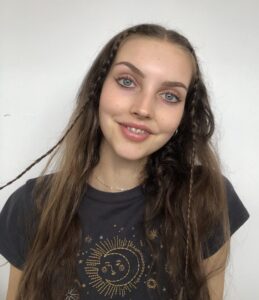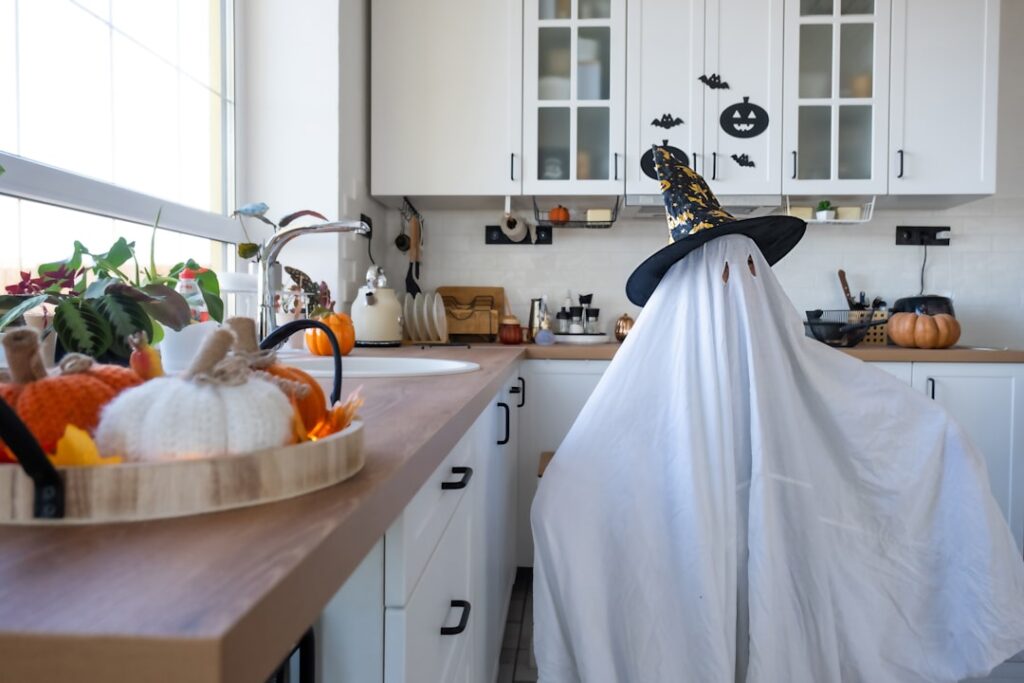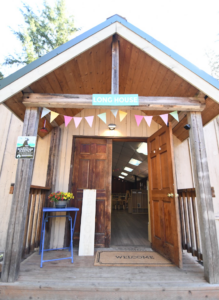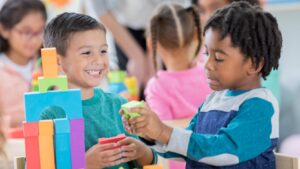
Rebecca Barry, MSc
Consultant
Halloween can be one of the most exciting days of the year for children, filled with costumes, creativity, and community fun! However, we also want to ensure that the children in our care stay healthy and safe – without us as caregivers turning into the ghouls spoiling the fun!
With a little planning, some smart swaps, and creativity, Halloween celebrations can be just as magical without compromising children’s health and well-being. We know that each family, child care institution, and home has their own practical and financial constraints, so just making the changes that you feel are accessible to you is a great improvement!
Costumes and Dress-Up – What’s all the fuss about?
Dressing up is one of the most fun and creative aspects of Halloween, but most shop-bought costumes are made of synthetic materials that are harmful to kids’ health. Per and polyfluoroalkyl substances (PFAS or “forever chemicals”), flame retardants, and microplastics are not-so-invisibly lurking in witches’ robes and robot buttons! We don’t want the scariest element of our kids’ costumes to be what they are made of.
“Halloween dress-up is only one day a year, so does it really matter?” “Is this small exposure to these substances really that harmful?” Well, granted, the health impacts from a single day aren’t likely to be huge. However, child care facilities often use these dress-up costumes year-round for play. Even small exposures over time have been proven to take a toll on kids’ health.
What are some alternatives and smarter choices for dressing up?
- Choose non-toxic face paint: Some face paints contain heavy metals and allergens. These can be absorbed into the skin – children’s skin soaks up these substances more easily. Look for water-based, hypoallergenic brands labeled “non-toxic” and conduct a small skin patch test first. Avoid costume makeup with fragrance or parabens. (Note: make sure you pick ‘fragrance free’, not just ‘unscented’, as “unscented” typically means that even more chemicals have been added to mask a pre-existing smell!)
- Skip plastic masks: These often contain phthalates or PVC (more info in our Factsheet). This is particularly harmful because they will go over kids’ mouths and noses and microplastics can be inhaled. Instead, use cloth masks from natural materials or encourage children to decorate hats, headbands, or capes.
Healthier Treat Alternatives
Kids love candy! We all deserve a sweet treat once in a while, but here are some tips to maintain a little bit of balance. We also have a healthy eating factsheet to take a look at, too!
- Vary the snacks: Instead of offering only sugary, processed treats, also provide options like fruit kabobs, popcorn, whole-grain crackers, or pumpkin muffins. Making healthy foods look interesting and exciting can encourage kids to choose them. You can also bake or make them as an activity! Allergy-conscious choices: Consider nut-free, gluten-free, or dairy-free options. Stickers, pencils, or small crafts can also be fun “treats” that don’t involve food.
Non-Toxic Decorations and Crafts
Cobwebs, critters, ghosts and ghouls, we love it all! How can we keep our spooky scenes environmental and kid-friendly?
- Skip artificial fragrances: Many air fresheners, scented candles and sprays release volatile organic compounds (VOCs). Try natural scents like cinnamon sticks or cloves.
- Choose natural décor: Pumpkins, gourds, dried leaves, and corn husks make festive, biodegradable decorations. You could even take the kids outside and forage for some materials!
- Craft safely: Use non-toxic paints, markers, and glue. Avoid glitter and spray paints, which can release microplastics or fumes. Check out our ‘Safer Art Supplies’ FAQ for more guidance.
Mindful Event Planning
Kids are all different in their preferences, worries, and capacities. Varied and well thought out activities ensure that everyone feels safe, comfortable, and has the opportunity to do something they enjoy.
- Inclusive activities: Plan a range of games and crafts that all children can enjoy, regardless of dietary restrictions or mobility challenges. Pumpkin bowling, scavenger hunts, or story circles are fun alternatives.
- Supervision and safety: If carving pumpkins, adults should handle sharp tools while children decorate with paint or stickers. Use flameless LED candles instead of real candles inside jack-o’-lanterns. You can also use non-toxic markers to draw faces instead of carving.
- Reuse what you can: Provide reusable bags for collecting goodies or encourage families to repurpose cloth bags for trick-or-treating.
Partnering with Families
Seasonal events can be a great way to promote community and grow relationships, if the environment is safe.
- Share safety tips: Provide families with simple reminders about costume safety, a variety of food and non-food treat options, and allergy awareness. We know that each family has their own financial, religious, and social circumstances, so be mindful of potential constraints when recommending best practices. For example, if non-toxic face paint is too expensive, could natural dyes from fruit be used instead? ,
- Promote community sharing: Encourage costume swaps or secondhand costumes to reduce waste and save money.
- Model healthy fun: When children see their caregivers making safe, non-toxic choices, they’re more likely to adopt these habits themselves. Tell your kids why you are making certain choices or swaps, and keep them involved.
A Spook Free Summary
Halloween doesn’t have to mean sugar overload, toxic materials, or safety hazards. With thoughtful planning, child care providers can create an environment where children feel safe, included, and excited to celebrate. By focusing on non-toxic materials, healthier treats, and mindful activities, we can keep the holiday magical—while protecting the health of the little ones in our care.
Resources
ACTIVITIES
Halloween activities with recycled materials
RECIPES






